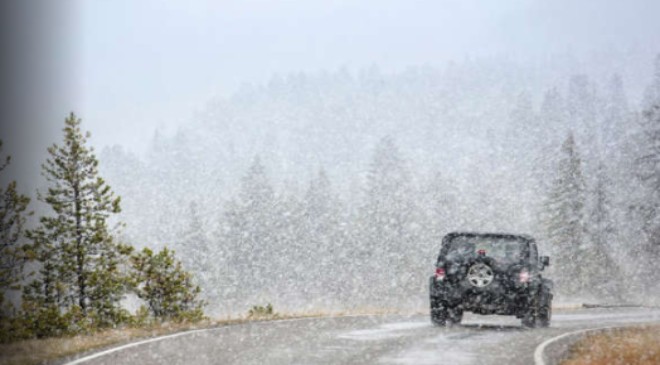The classic road trip is having a vacation moment.
In May 2021, AAA revealed that 34 million people took to the roads for a Memorial Day trip, marking an increase of 52% compared to 2020. And, in April 2021, Motel 6 unveiled its vacation report, which showed that more than half (56%) of the respondents said they were more likely to take a road trip in 2021 than in previous years. People are indeed falling in love with the open road once again. However, there are a few things drivers should be wary of before setting off on a journey, especially if road tripping in the winter, when conditions can be more dangerous depending on the destination.
“The most important thing to remember is to drive slowly and steadily, as snowy or icy roads can block the view and raise the risk of skidding,” Anthony King, CEO of Transport Executive, shared with Travel + Leisure via email. “In the winter, skidding is a common occurrence that can result in injury to you and your vehicle. In the event of a skid, stay calm and avoid slamming on the brakes, as this may cause you to lose control of your vehicle. The ideal method is to take it easy on the pedal and shift slightly into the skid before slowly accelerating.”
Here are five more tips for driving in the snow that will help keep you safe on any winter road trip.
Warm up your vehicle before driving.
Thomas Brown, a driving instructor from Fairbanks, Alaska, with 30 years of experience, shared a piece of advice both you and your car will appreciate: If you’re in a cold environment, let your vehicle warm up before leaving the driveway.
“Wait 30 seconds to a minute after the engine starts before driving,” he explained. Not only will this allow you to turn on the heat faster, but it will also allow your engine to perform at its best. “You should stay at a low speed. The engine speed is best kept at 2,000 RPM. Try not to exceed 3,500 RPM. Wait until the engine temperature rises to a normal operating temperature, then raise the speed.”
Install skid chains or snow tires.
If you’re traveling to a snowy area, Brown also suggested installing skid chains or replacing your vehicle with a set of snow tires.
“Both of these items can enhance the grip of the vehicle to avoid skidding, but the skid resistance of snow tires is much better than the chain,” Brown said. “If you live in an area that has more than three months of snowfall a year, I recommend getting a new set of snow tires for your vehicle. If the snowfall doesn’t last long, installing a set of skid chains is adequate.” If you don’t feel like this is a task you can do alone, visit your local auto shop for a little help.
Perform some basic vehicle maintenance.
According to Ferenc Elekes, founder and editor of Overlandsite, which provides expert advice for overlanding, it’s key to take care of your car so it can take care of you.
“First and foremost, maintenance is very important. Your car must be ready for the challenges winter conditions throw at it,” Elekes said. “The key things to check are your tires, brakes, battery, radiator, wiper blades and fluid, lights, defrost and heater, other fluids, and if possible, run diagnostics. Having your car in tip-top shape will not only increase your safety, but it will also give you peace of mind, which will make driving in winter more relaxed.”
Elekes also added that it’s a good idea to spend a little more on some upgrades if you can. “Changing the oil, upgrading tires, using different fluids, adding interior protection, and washing and waxing your car add extra protection for you and your vehicle functionally and aesthetically.”
Pack for emergencies.
As Murphy’s Law states, “Anything that can go wrong will go wrong.” You can prep for this by packing for any and all emergencies, according to Elekes.
“For your safety, it’s advisable to pack some emergency essentials,” Elekes said. “Depending on the length and style of your trip, essentials can range from the bare minimum, like a hazard triangle, ice scrapers, and tire chains, to being prepared for anything with tow straps, an extra battery, a shovel, tools for small repairs, and ice melt and traction materials.”
Do your homework on the route.
Odds are, when planning a road trip, you’ll likely research your destination, including things like accommodations, attractions to see, and places to eat. But Kyle Kroeger, founder of ViaTravelers, recommends taking things one step further by looking up winter conditions as well.
“Do research on the area you’re visiting and speak to the locals for advice on places to avoid and places you can visit most safely,” Kroeger said. Furthermore, it can be a good idea to research gas stations along your route and the distances between them. “Make sure you never run out of gas,” Kroeger warned. “If you’re at all concerned about running out, turn back immediately.”







































